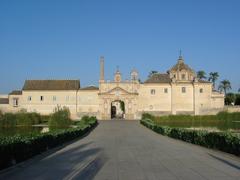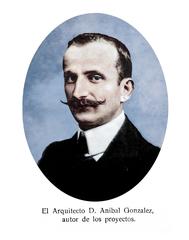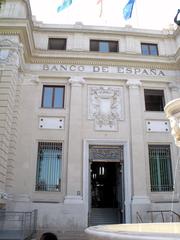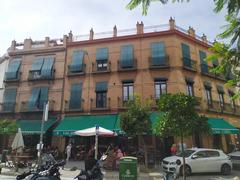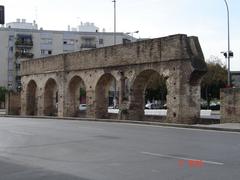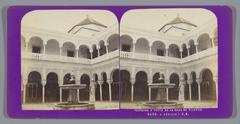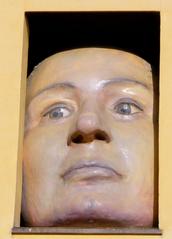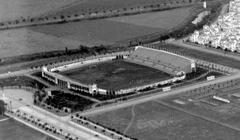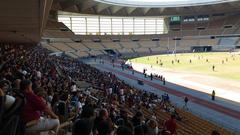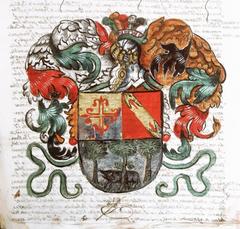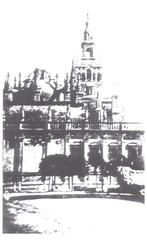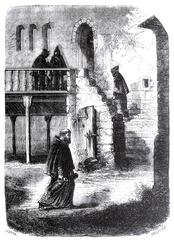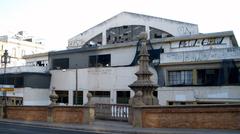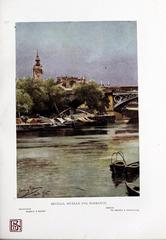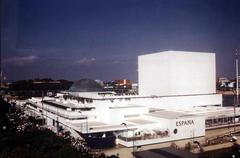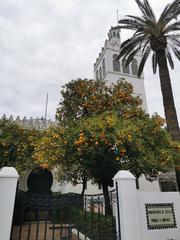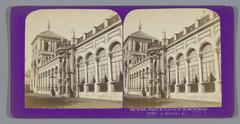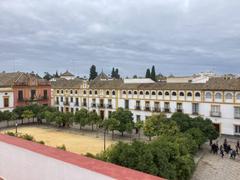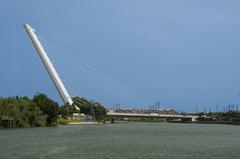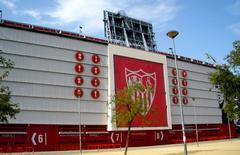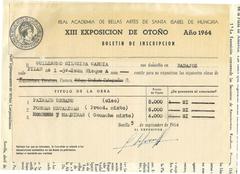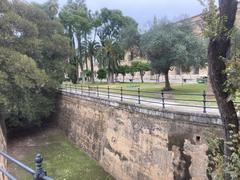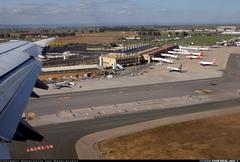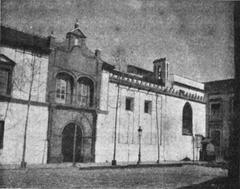Hilaturas y Tejidos Andaluces S.A. (Hytasa) – Visiting Hours, Tickets, and Seville Historical Sites Guide
Date: 14/06/2025
Introduction
Located in Seville’s historic Cerro del Águila neighborhood, Hilaturas y Tejidos Andaluces S.A. (Hytasa) stands as a major symbol of Andalusia’s industrial transformation during the 20th century. Founded in the late 1930s and inaugurated in 1941, Hytasa played a crucial role in Spain’s post-Civil War recovery, shifting the region from an agrarian economy to a center of modern textile production. Today, the site offers visitors a unique blend of industrial heritage, architectural significance, and ongoing community engagement, making it an essential stop for anyone interested in Seville’s multifaceted history (RTVE; Docomomo Ibérico).
Table of Contents
- Historical Overview
- Architectural Features
- Industrial and Social Impact
- Visiting Information
- Nearby Attractions
- Frequently Asked Questions (FAQ)
- Conclusion
- References
Historical Overview
Foundation and Growth (1941–1970s)
Hytasa was established in 1937 and officially inaugurated in 1941 as part of Spain’s efforts to revive its economy following the Civil War. The factory introduced large-scale textile production to Seville, specializing in spinning and weaving cotton, and quickly became one of the region’s largest employers. At its height during the 1960s, Hytasa provided stable jobs for over 1,000 workers, catalyzing the development of Cerro del Águila and surrounding districts (Sevilla Actualidad; Empresite).
The factory’s influence extended far beyond its economic contributions. It fostered a strong sense of community among workers, offering social clubs, sports teams, and cultural activities, and contributed to the neighborhood’s infrastructure with housing, schools, and shops.
Labor Struggles, Decline, and Closure (1970s–1990s)
By the 1970s, Hytasa faced mounting challenges due to international competition and technological change. Economic difficulties led to labor unrest, most notably in 1977, when a protest resulted in violence and highlighted the factory as a focal point of labor activism in Andalusia (eldiario.es). In 1982, the Spanish government intervened, nationalizing the factory to prevent its collapse and investing heavily in restructuring (EUR-Lex). Despite these efforts, continued decline led to privatization and eventual closure in the 1990s, marking the end of an era for Seville’s industrial sector (Modaes, 2019).
Adaptive Reuse and Contemporary Role
Though production ceased, Hytasa’s legacy lives on through its adaptive reuse. The site now hosts administrative offices for the Andalusian Regional Government and serves as a venue for cultural and community activities, including textile recycling initiatives. These projects not only preserve the architectural and historical value of the factory but also breathe new life into the surrounding neighborhood (Cruz y Ortiz Arquitectos; Modaes, 2019).
Architectural Features
Designed by architects José Galnares Sagastizábal and Juan Talavera y Heredia, Hytasa exemplifies Spain’s rationalist and modernist industrial architecture of the mid-20th century (Docomomo Ibérico). The factory complex covers over 41,000 square meters, with a grid-based layout that maximizes efficiency and natural light. Key features include:
- Open-plan production halls: Large, column-free spaces for flexible machinery arrangements.
- Rationalist design elements: Functional forms with restrained decorative details.
- Integration with urban fabric: The factory’s layout influenced surrounding residential and commercial development.
Hytasa’s distinctive architecture stands in contrast to Seville’s medieval and Baroque landmarks, offering visitors a window into the city’s industrial ambitions and modernization efforts (Civilisable; Architecture of Cities).
Industrial and Social Impact
At its peak, Hytasa was a key driver of Seville’s economy, employing thousands and supporting ancillary industries. The factory’s role extended into the social sphere, shaping local identity and fostering solidarity through worker programs, cultural events, and labor activism. Importantly, Hytasa provided opportunities for women in the workforce, contributing to shifts in gender roles and economic independence during the 20th century.
The decline and closure of Hytasa in the 1990s left a lasting impact on the community, leading to unemployment and social challenges. Nevertheless, the site’s continued relevance is ensured through adaptive reuse and community engagement, including textile recycling and cultural programming (Modaes, 2019; Sevilla Actualidad).
Visiting Information
Hours and Admission
- General Access: Hytasa is primarily accessible via guided tours and cultural events organized by local authorities or community groups.
- Usual Hours: Guided tours are typically held Tuesday to Saturday, 10:00 AM to 6:00 PM, but schedules may vary. It is essential to check with the Ayuntamiento de Sevilla or official tourism sites for up-to-date information.
- Admission: Entry to most public events and tours is free; some special activities may charge a nominal fee. Tickets can be reserved online or at the site during open events.
Accessibility
- The site is wheelchair accessible in most repurposed buildings, with ramps and elevators available. Notify organizers of any specific needs when booking your visit.
Getting There
- Address: Calle Huerto del Maestre s/n, 41006, Seville, Spain (Empresite)
- Public Transport: Bus lines 24, 27, 28, 52, and 2 serve the area; Amate metro station is a 10-minute walk away.
- Parking: Limited; public transport is recommended.
Visitor Tips
- Best times to visit: Spring and autumn offer the most comfortable weather; early mornings and late afternoons are ideal during the summer.
- Language: Spanish is predominant; basic phrases or a translation app is useful.
- Safety: The area is generally safe, but standard urban precautions apply.
- Photography: Permitted in public spaces; ask permission before photographing people or private interiors.
- Payments: Carry some cash for small vendors; not all accept cards.
Nearby Attractions
- Parque Amate: A large park ideal for relaxation, picnics, and outdoor activities.
- Seville Old Town: Includes must-see sites like the Seville Cathedral and Alcázar, a short ride away.
- Centro Cerámica Triana: Explore Seville’s rich ceramic tradition.
Frequently Asked Questions (FAQ)
Q: What are Hytasa’s visiting hours?
A: Guided tours are usually available Tuesday to Saturday, 10:00 AM to 6:00 PM, but check current schedules before your visit.
Q: Is there an entry fee?
A: General admission is free; some tours or events may charge a small fee.
Q: Is Hytasa accessible for wheelchair users?
A: Yes, most areas are accessible.
Q: Are guided tours available?
A: Yes, but they must be booked in advance or attended during scheduled events.
Q: How do I get to Hytasa by public transport?
A: Bus lines 24, 27, 28, 52, and 2 serve the area. The Amate metro station is nearby.
Conclusion
Hytasa exemplifies Seville’s industrial evolution, architectural ambition, and enduring community spirit. The site’s transformation from a textile powerhouse to a center for government, culture, and innovation illustrates the dynamic interplay of history and modernity in Andalusia. Whether you are a history buff, architecture enthusiast, or cultural traveler, Hytasa offers a meaningful and memorable experience. Plan your visit, check for upcoming tours and events, and take the opportunity to connect with Seville’s living heritage.
For personalized recommendations and the latest updates on visiting Hytasa and other Seville sites, download the Audiala app and follow local cultural channels.
References
- RTVE
- Docomomo Ibérico
- Modaes, 2019
- ABC Sevilla
- Cruz y Ortiz Arquitectos
- EUR-Lex
- Sevilla Actualidad
- eldiario.es
- Empresite
- Civilisable
- Architecture of Cities
